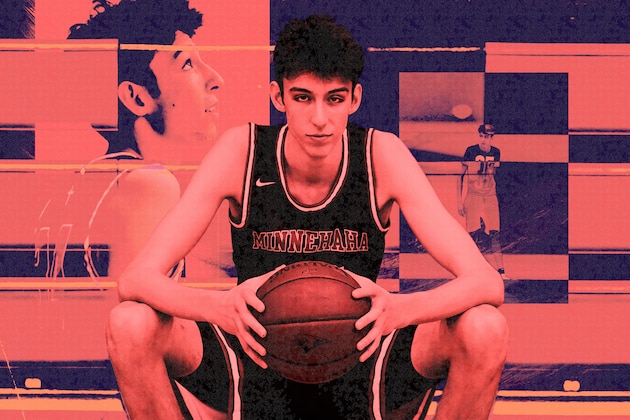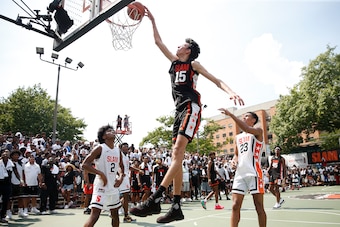Featured Video
Astros, Angels Clear Benches 🫨

Once 'A Pile of Bricks,' Chet Holmgren Is Now Basketball's Dream House
Chet Holmgren counted only four players on the opposing team. It was Day 1 of the 2019 SC30 camp, and coaches were rewarding the young players in attendance with a run after a morning of drills. As Holmgren's teammates each matched up with a man to guard, he waited patiently for the fifth player to appear. He saw Stephen Curry, the camp's namesake, on the court. Holmgren was going to ask him where the last player was, but then he realized: Curry wasn't on the court to coach. He was there to play.
"I'm like, Oh, hi. I'll go guard him," Holmgren says. "Never scared. Never back down."
TOP NEWS

Ranking the Top 50 NBA Playoff Performers of All Time

Rachel DeMita Fired by BIG3 After Caitlin Clark Posts During BIG3 Game

1 Player Most Likely To Be Traded On Every NBA Team
Holmgren, a junior from Minnehaha (Minnesota) Academy, is 7 feet tall but considers himself positionless, and he viewed the chance to defend Curry as a welcome challenge. Early on, he got the upper hand when he saw Curry cut back-door for a quick layup and recovered in time to swat the would-be layup off the glass. On the next possession, Curry saw Holmgren slacking and punished him by pulling up from 28 feet. "It was kind of vicious," Holmgren says. But no one remembers any of those plays from that day. The only thing anyone remembers is what happened next.
Holmgren got the ball at the right wing. Curry, appearing to play at about half speed, was idling upright in front of him. Holmgren crossed the ball, right hand to left hand, between his legs. Then, behind his back, he crossed left to right and right to left again. When Curry bit on the left hand, Holmgren doubled back and drove with his right hand to the rim, dunking the ball emphatically. A gangly high schooler had just used Curry's own move against him.
When he subbed out of the game a few minutes later, Holmgren sat next to his friend, Paige Bueckers, on the bench. Bueckers, the No. 1 player in the class of 2020 and a UConn commit, per ESPN.com, told Holmgren he looked a little too nonchalant about what had just happened. "Do you realize what you've done?" she said. "You're going to go viral!"
After the game, Curry congratulated him. "You got me on that one," he told Holmgren. Then the highlight started spreading. Holmgren got more texts and Snapchats and DMs than he could respond to. His Instagram got more than 500,000 visits that week. He picked up prominent followers, such as recently retired Miami Heat star Dwyane Wade. For Holmgren, it was the exclamation point on a story he'd been writing all summer.
Before his sophomore season, Chet had just two scholarship offers and was ranked in only one recruiting service. Now a junior, he's considered the No. 1 center in the class of 2021—and the No. 4 player overall. And as he hinted at the SC30 camp, he could be the NBA's next unicorn.
"I've done this for a lot of years, and you realize that when you get a kid like a Chet, it's probably a once-in-a-lifetime situation," Minnehaha coach Lance Johnson says. "I don't know how many schools out there that never get the opportunity to have a 7-footer who can handle the ball, who shoots, who has a great attitude, who works hard and who you don't have to worry about in the classroom. He's very unique."
Even strangers can see that Holmgren is a basketball player. When the 17-year-old walks around malls in Minneapolis, people stop to ask him if he plays the sport. And it's not just about his size. Around town and at Minnehaha, he wears the standard off-the-court uniform for young athletes: $200 sneakers, joggers and an athletic hoodie. And he holds his speakerphone up to his high-altitude head to listen to YoungBoy.
When Brian Sandifer first met Holmgren, though, he didn't see a future star. In fact, he wasn't even sure he saw a roster spot for the scrawny third grader on his youth team. Holmgren had shown up for the first tryout in cargo shorts, a polo shirt and a bowl cut. "He was probably as big as a pencil at that time," Sandifer says, "but really long, frail and really weak." But then Sandifer saw Chet's dad, Dave Holmgren.
Dave is 7 feet tall and formidable. He appeared in 57 games for the University of Minnesota in the late 1980s. Bad knees limited his career minutes (5.4 per game) and production (1.0 points and 0.7 rebounds per game). But he passed down his height and passion for the game to his only son. While Dave got Chet interested in basketball, he wanted to be his son's father and not his coach. Through a friend, he'd heard about Sandifer's success in developing raw prospects, and he brought his son to be next. It would be a challenge, especially for Chet, who started with a surplus of height but a shortage of skills.
"I cried after the first week of practice, every practice," Chet says. "I just couldn't handle it. But the way I was born, I've never really been somebody to like take a hit and just lay there. I'll get hit, and I'll get back up."
He didn't play much in those early years. He had to manage growing into his body while also growing his game. At home, Dave taught Chet some big-man fundamentals—like how to box out for a rebound and how to avoid fouling with your body when blocking shots. With Sandifer, Chet spent most of his time trying to play like the guards a grade ahead of him. One of them was Jalen Suggs, a 2020 top-10 recruit who is still Chet's AAU and high school teammate. During games, Chet would watch his friend's footwork. And in practices, he'd try his best to mimic Suggs' shooting and moves.
"People think it's important to be scoring like 45 points a game by third grade, but it's not," Chet says. "Learning how to play basketball is important. I learned fundamentals. I was a project, but people were willing to take time with me. They turned a pile of bricks into a house. Actually, I wasn't even a pile of bricks—I was whatever you make bricks out of."
In sixth grade, Chet followed Jalen to Minnehaha, a prestigious private Christian school. He was 6'2" at the time and spent part of the first season rehabbing from a broken right wrist—his shooting hand. He used the injury as an opportunity to expand his shooting range. His skills were expanding, but he was still just too skinny and too much of a project as a low-post player to be a reliable part of the rotation.
For the next few years, he used his time on the bench as an opportunity to refine his three-point shooting and ball-handling skills. By the ninth grade, he had sprouted another seven inches and started to see playing time on varsity. He was primarily a defensive specialist, but he managed to put up 6.2 points and 3.0 rebounds per game.
Whereas many big men develop on a single track, focused on low-post fundamentals like over-the-shoulder shots and rebounding position, Holmgren had developed on parallel tracks. He was simultaneously learning about the brute force necessary to be a big and the finesse necessary to be a guard. The parallel tracks held him back until his sophomore year, when all his work behind the scenes led to a breakout season. He averaged 18.6 points and 11.0 rebounds per game and helped Minnehaha win a third straight Minnesota 2A basketball championship.
Over the summer, playing for Sandifer's Grassroots Sizzle on the Under Armour 17U circuit, he blocked 49 shots in his first six games. In a matchup with Mudiay Elite, he finished with 19 points, 13 rebounds and nine blocks. College coaches took note, and the offers started pouring in from dozens of D-I schools, including Kansas, Gonzaga, Memphis, Florida and Minnesota.
"The last summer, for me as well as for the rest of the world, was really eye-opening," Suggs says. "Chet decided it was time to kick it up a notch and let it be known that he's here, that he wants to stay and that he's one of the best players in the country."
Holmgren's perimeter skills are well-suited to the modern NBA, where centers are tasked not just with patrolling the paint, but also stretching the floor with three-point shooting. Holmgren models his game after some of the league's most versatile big men: Kevin Durant, LeBron James and Giannis Antetokounmpo. He likes how Durant can score at every level, how James facilitates and how effective Giannis is as a downhill player. But Chet is a 'tweener, even as a college player. To be an effective 5, he will need to develop some low-post moves and put on at least 30 pounds. (He weighs 190, which roughly is the same as Curry.) And to play on the wing, he will have to show he can hang with smaller, quicker players on the perimeter. But for now, he prefers to be positionless.
"I can be very effective at the 4 or 5 spot, but I feel that's limiting," he says. "I can do more than that. I can go farther than that."
On a November afternoon, Holmgren slips into his Minnehaha uniform for the first time this fall. He wears No. 34—not because he likes the number, but because it's the only jersey the school has that fits him. It's one of the many limiting factors of his height. He also can't fit into normal airplane seats, can't go to the mall without being asked for an autograph by someone who doesn't know his name and can't buy Nike Huaraches, since they only go up to size 14. But he can grab a dollar off the top of the backboard, and he's willing to take the trade-offs that come with standing in the far corner of the height distribution.
As Holmgren dribbles around, Suggs slips into the gym and watches him play. He's asked about Holmgren's highlight against Curry, but he remembers another time when his teammate was on the business end of a viral moment. In the 2018 Minnesota 2A semifinal, an unranked recruit named Mitchell Plombon posterized Holmgren. The clip spread from social media to SportsCenter, where Holmgren was identified not by name but as "the taller defender." In less than 18 months, Holmgren has gone from being a nameless big man to being a candidate for the No. 1 spot in his class.

"Handling all the attention has meant pushing it away and not focusing on it," he says. "If you pay too much attention to it, it'll get to you. I try to be the same person I was a year ago, two years ago, five years ago. I'm the same goofy, hardworking person I've always been."
From the bleachers, Suggs watches Holmgren throw down a dunk. Holmgren hangs on the rim and tugs it down toward the ground. Eventually, he's standing almost flat-footed on the floor of the gym with all 10 of his fingers still wrapped around the rim. Suggs laughs at the sight.
"We thought he'd be good," Suggs says. "We just didn't know that he'd be this good. We didn't know he'd be this tall. I can't wait to see what happens next."
Recruit rankings via 247Sports unless otherwise noted.






